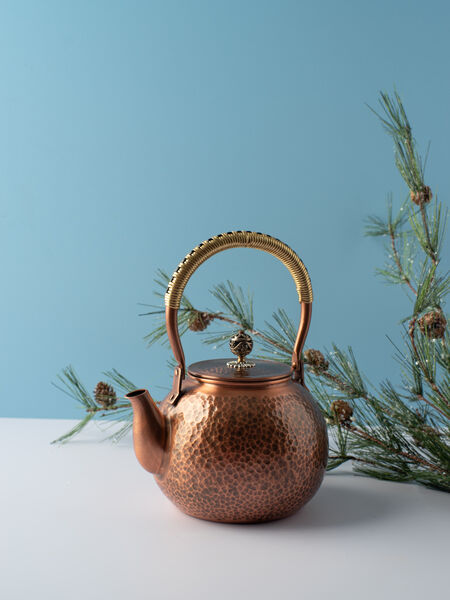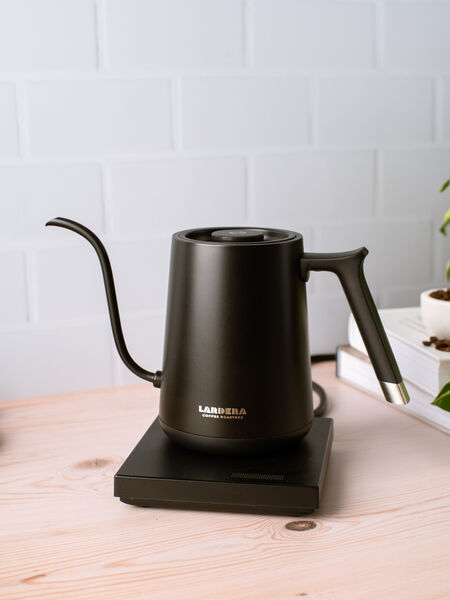Copper, Electric, or Tea Maker? Find Out


Water, water, everywhere, but not a drop at the correct temperature to brew tea. That’s where tea kettles come in. Sure, you could probably pop a cup of water in the microwave, but how do you know that water will come out the ideal temperature for brewing tea? For optimum (as well as consistent) results, no tea drinker should be without a good kettle to heat water. Looking for a kettle but don’t know which is the best type for you? Find your next tea tool with this quick guide.
Stovetop Kettles
The traditional method of boiling water, stovetop kettles look like giant teapots made of metal that are placed on a heat source (typically a stove). While they may look like giant teapots, stovetop kettles are only used to heat water while tea is brewed in another vessel. They’re usually made from stainless steel, but can be made of other metals such as copper. Some come equipped with a whistling mechanism that releases steam when the water has reached boiling point, but there are silent kettles available.
To use, simply add water to the kettle (don’t fill it up: you don’t want water to boil over), close the lid on top, and place over a heat source on high heat. Then, when the water has reached the appropriate temperature, remove the kettle and pour the water over some tea leaves in a vessel.
Pros: A stovetop kettle doesn’t require electricity to run by itself: only a heat source. While most might use a stovetop kettle on a stove, it can be used with other heat sources such as a campfire. It can also be washed easily without having to worry about getting any electrical components wet.
Cons: While some stovetop kettles come with an attached thermometer, many don’t, meaning you’ll have to monitor water temperature so it doesn’t get too hot for the tea you want to make. This can be done by purchasing a separate thermometer or simply eyeballing the water. Additionally, stovetop kettles shouldn’t be left alone while on a heat source that needs to be turned off manually.
Ready to try a Stovetop Kettle? Try either the Handmade Copper Kettle or the glass Water Kettle!
Electric Kettles
Electric Kettles make achieving the correct temperature for your water easy and convenient. These kettles do not need a stove or separate heat source to heat water but rather have a heating element built into the kettle itself. There are two parts to an electric kettle: the kettle itself and the base. The kettle begins to heat when it is on its base and it’s turned on. There are safety features built into electric kettles that will turn off the machine if a certain amount of time has passed while not in use or if there isn’t enough water in the kettle.
Depending on the kettle, they can be simple or complex: some have one “on” setting that will heat water to boiling, while others have multiple settings for different temperatures. Some electric kettles that specialize in tea will have delicate, green, white, oolong, black, or herbal tea options, taking a lot of the guesswork out of brewing the perfect cup. Electric kettles are a great choice for places that don’t have a stove, such as an office or dorm room.
While each electric kettle has its own set of instructions, the instructions are generally consistent across the board. Fill the tea kettle with the amount of water you want to heat, paying attention to the minimum and maximum lines marked on the kettle. Select a heating option if available, and press the “on” or “start” button on the kettle. Once the water reaches the correct temperature, the kettle will beep indicating that the water is ready. Pour into your favorite brewing vessel over some tea.
Pros: Electric kettles make brewing tea easy and convenient. They don’t require an external heating source since it’s already built into the kettle. Unlike using a stove, they don't have to be monitored while the water is heating up to the correct temperature and will turn off on their own if not being used for a long period of time. Some kettles will even keep the water warm for a period of time (usually an hour)
Cons: While electric kettles can make tea brewing easier, they do require some maintenance from time to time. Descaling is highly recommended to keep limescale out of your teapot as well as keep it from hindering the functionality of your kettle: descaling can be done either with vinegar or with descaling tablets. Additionally, it’s important to keep the electrical components of the kettle dry during cleaning: water and electrical components do not mix.
Ready to try an electric kettle? Try the varieTEA Kettle, a kettle that specializes in heating water to the correct temperature for a variety of teas. Or, though on Adagio's coffee website, Lardera, their Smart Electric Kettle is a master of precision and speed.
Tea Makers
If electric kettles make brewing tea easy, then tea makers make things even easier. Tea makers may look like another electric kettle, but they have one additional feature: they will brew tea for you! Tea makers usually have three parts: a base, a kettle, and a removable infusion basket. Unlike typical stovetop or electric kettles, tea can be added to the kettle of a tea maker (though tea makers will still have a “heat water only” option).
Tea Makers usually work by circulating the heated water through the infusion basket for a certain amount of time to completely brew the tea; then simply pour the tea directly into your favorite cup. No more pouring water from a kettle into a separate teapot, setting a timer, and running back to the teapot before the tea overbrews. Depending on the tea maker, there will either be preset options for the individual tea types for both temperature and brewing time or dials that allow the user to customize temperature and brewing time. Some tea makers, like Teforia, even have a smart phone feature that will automatically set the correct time and temperature.
Like with electric kettles, each tea maker will come with its own set of instructions. Generally, you fill the kettle with the right amount of water (again, paying attention to the minimum and maximum lines), fill the infuser basket with the right amount of tea (usually one teaspoon per cup), close the lid, choose the correct settings, and press “start”. The kettle may beep when the water has reached the correct temperature and when brewing is done. Simple, easy, and convenient.
Pros: Tea Makers take all the guesswork out of making tea. You don’t need to monitor the water temperature or even the brewing time: tea makers will do that all for you. You don’t even need a separate teapot to brew the tea: you can pour cups of tea directly from the kettle itself.
Cons: A good tea maker will cost more than a typical electric or stovetop kettle, so they might not be ideal for the novice tea drinker just beginning their tea journey. They will still require the same maintenance as an electric kettle (such as descaling), and the electrical elements should be kept dry during cleaning. Since tea can be brewed in the kettle, you’ll have to clean out the kettle after each brewing (though cleaning is easy: simply rinse out the kettle with water when you’re done).
Ready to try a tea maker? Let velociTEA take the guesswork out of making the perfect cup of tea!
